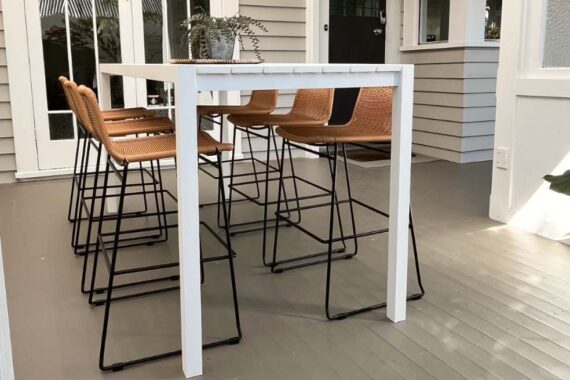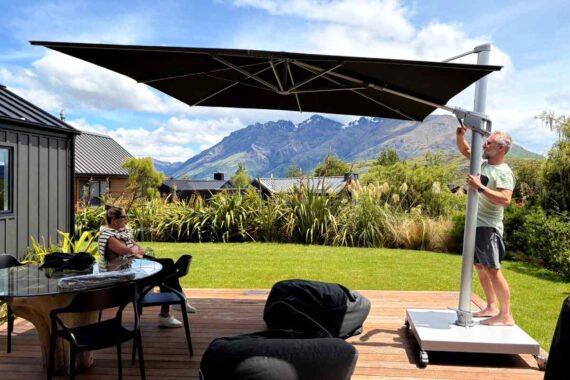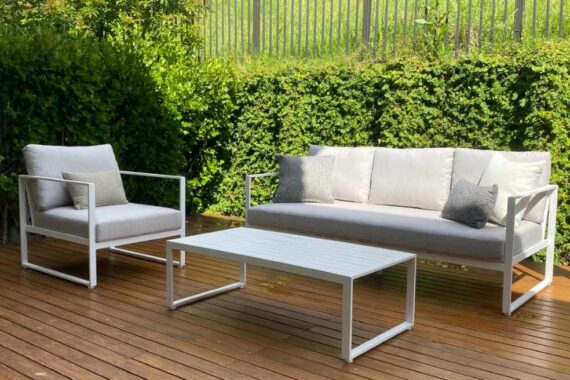Here at Outside Space NZ, we love and appreciate a great outdoor cantilever umbrella. They are stylish, functional, and the perfect sunshade solution for your outdoor space.
In serving hundreds of Kiwi clients, we’ve noticed a few common misconceptions customers have when cantilever umbrella shopping and trying to assess their umbrella requirements.
We’ve summarised the top 7 mistakes we see to make sure you choose a cantilever umbrella suited to your outdoor space.
That umbrella is too big for that space! It’s easy to look at the numbers and assume the umbrella size is the only dimension that matters, but the frame and base need space, too.
The Mistake: Not factoring in the physical footprint of the base, the vertical support pole, and the slight overhang of the fabric canopy, which needs room to rotate. This can lead to a tight squeeze, or worse, prevent the umbrella from being placed where you need it most.
The Fix: Always allow for an extra 300 mm to 500 mm of clearance around the base and pole. If you have a square space that is 3M × 3M, consider the slightly smaller umbrella, either the 2.5M × 2.5M or a 3M round umbrella. This ensures comfortable rotation.

Many customers seek the largest umbrella their space can handle, but they often underestimate the value of adjustability and coverage of multi-tilt umbrellas.
The Mistake: Underestimating how much an umbrella’s tilt function improves your sun protection. By mid-afternoon, when the sun is low and blazing in sideways, a smaller shade with left/right tilt functionality provides ample shade for your outdoor dining set or lounge. A larger canopy with less tilt functionality isn’t as effective.
The Fix: The true power of a cantilever is its adjustability. Choose an umbrella with a full 360∘ rotation, ‘left- right’ tilt and ‘up-down’ tilt. Our multi-tilt umbrellas ‘punch above their weight’ in shade because their adjustability lets you follow the low-angle sun throughout the entire day, protecting your space from dawn till dusk without moving the base. As a general observation, we find customers often buy a size smaller than they came in for!

Cantilever umbrellas are designed to lift and extend, and their arms (ribs) move a surprisingly long way, especially on larger models.
The Mistake: Placing the umbrella too close to a wall, the back of the outdoor sofa, or a fence. When you try to open, close, or tilt the umbrella, the ribs hit the obstacle, preventing full function or potentially damaging the fabric and frame. The ribs of a closed umbrella can sit anywhere from 200mm to 1m off the ground, depending on the umbrella’s size.
The Fix: Before purchasing, try opening the umbrella in-store to ensure there is plenty of clearance from all nearby structures (outdoor furniture, plant pots etc) to allow a full range of motion. Pro tip: If you need to butt your umbrella up close to your outdoor furniture, round umbrellas are often a better choice than square as the rib ends are shorter, and provide more clearance during opening.
We regularly try this out in our showroom for customers, and they tell us this is a factor they had not considered before!
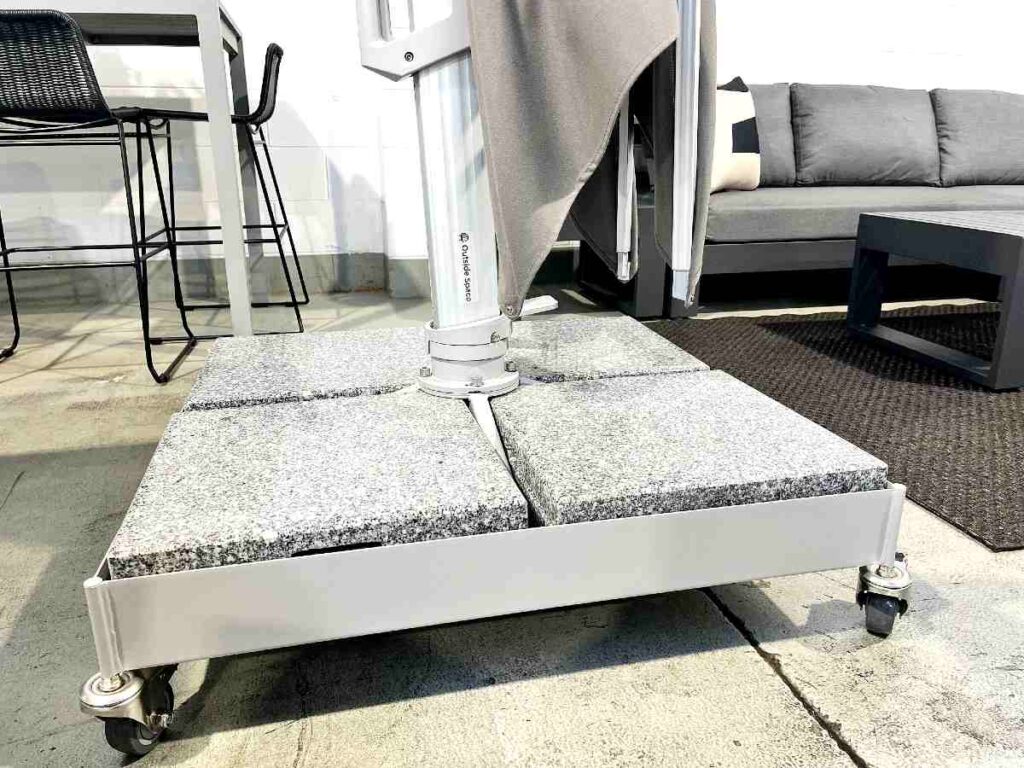
A cantilever umbrella is essentially a giant sail on a lever. The further the canopy hangs from the central pole, the more leverage the wind has to lift or topple it—especially in our famously windy Kiwi conditions!
The Mistake: Yes it is cheaper (and therefore, enticing) to buy a smaller/lighter base that is underspecified for the size of the cantilever umbrella canopy. This is a false economy.
The Fix: Don’t compromise on base weight. In our case, our 2.5M x 2.5M umbrellas are sold with a 100kg base. That size of umbrella is actually specified for a min 90kg base but we bumped it up to 100kg base on wheels – it is NZ after all!. We specify our larger 3M x 3M umbrellas with a 140 kg base on wheels (bumped up from the minimum specified 120kg) , and our 3.5M x 3.5M umbrellas have a 210kg granite base on wheels! This is the ultimate in stability and security. We simply will not sell a larger umbrella with a smaller lighter weight base.
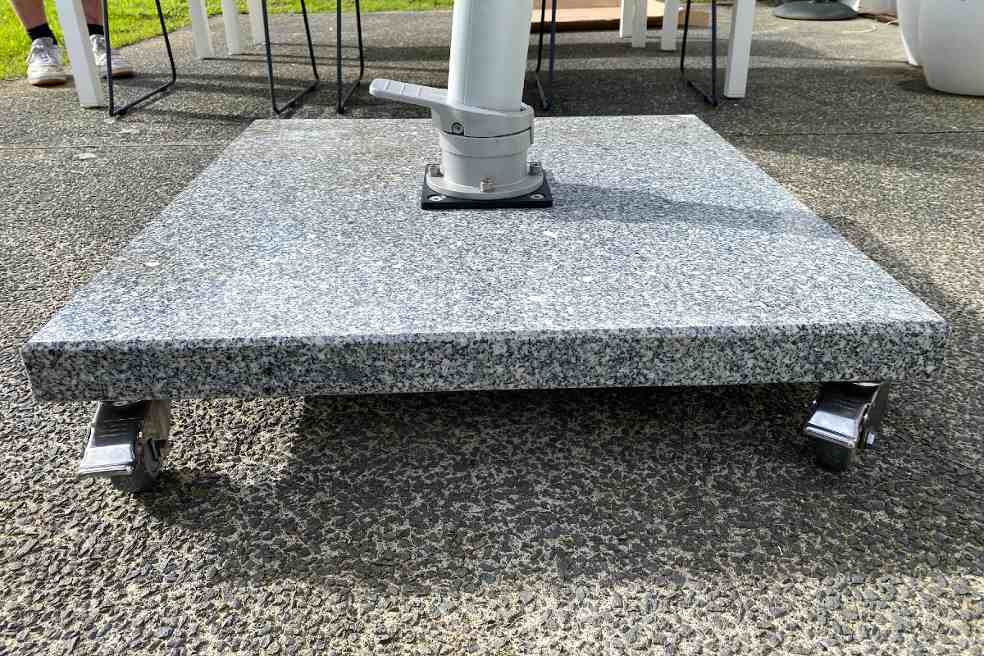
While functional, a cantilever umbrella’s primary job is shade, not privacy, and definitely not wind protection.
The Mistake: Customers sometimes want to use the umbrella as a privacy screen from neighbours or as a windbreak by tilting it vertically. Or, in a few cases, customers want to leave it open constantly to protect their house’s interior from extreme sun. These applications require the umbrella to be left open, often tilted into the wind, and often unsupervised.
The Fix: Stick to the golden rule: Only have your umbrella open if you are sitting under it. If you need privacy or a windbreak, consider installing a separate screen or strategically placing a louvre. When you leave an umbrella unattended, or if the wind picks up, always close it immediately.
A quality umbrella is a long-term investment that should be backed up by a solid local promise.
The Mistake: Buying an unknown brand with a generic vague 1-year warranty that offers no NZ-based after-sales support or spare parts. We regularly receive calls from people whose hardware store umbrella has failed, and they want to buy a granite base, parts or a new canopy from us—and we are unable to help them.
The Fix: Look for a business that backs its product. A good quality cantilever umbrella should have a substantial warranty: typically, 3+ years on the frame and 5 years on the premium fabric (like Sunbrella or similar) against fading. Buying from a trusted local supplier ensures you have access to expertise and parts for the life of the product.
The advertised price is often just the beginning.
The Mistake: Looking at the initial price and not realising it doesn’t actually include the cost of the heavy base, or the essential rain cover. You might see a price that looks great, only to find the “extras” double the cost, or the umbrella’s specs (such as the pole material or wind rating) are significantly inferior to a slightly pricier model.
The Fix: Always ask what is included in the total price. A premium purchase should bundle key items: umbrella, heavy base weights, and a protective cover. Does delivery cost include set up? Compare the core specs: What is the actual wind rating? What material is the pole made from? (We prefer durable anodised aluminium, not powder-coated) Make sure you are comparing a complete, quality, wind-rated package designed for New Zealand conditions.
In summary, this blog summarised the common mistakes people make when assessing their outdoor umbrella requirements. If you are interested in learning more about the key factors that affect cantilever umbrella pricing in New Zealand such as canopy fabric, materials of the post and ribs, wind rating), then click here.
We look forward to helping you determine the size and type of cantilever umbrella you may need. We’ll ask you the hard questions to make sure you purchase the best cantilever umbrella for your outdoor space.
We’d love to see you at our showroom to try out our selection of high-quality, wind-rated cantilever umbrellas designed for New Zealand conditions.
Kerry is the co-owner of Outside Space NZ, offering a range of contemporary outdoor furniture and sun umbrellas for coastal living kiwis seeking premium quality outdoor products and design at achievable prices.
